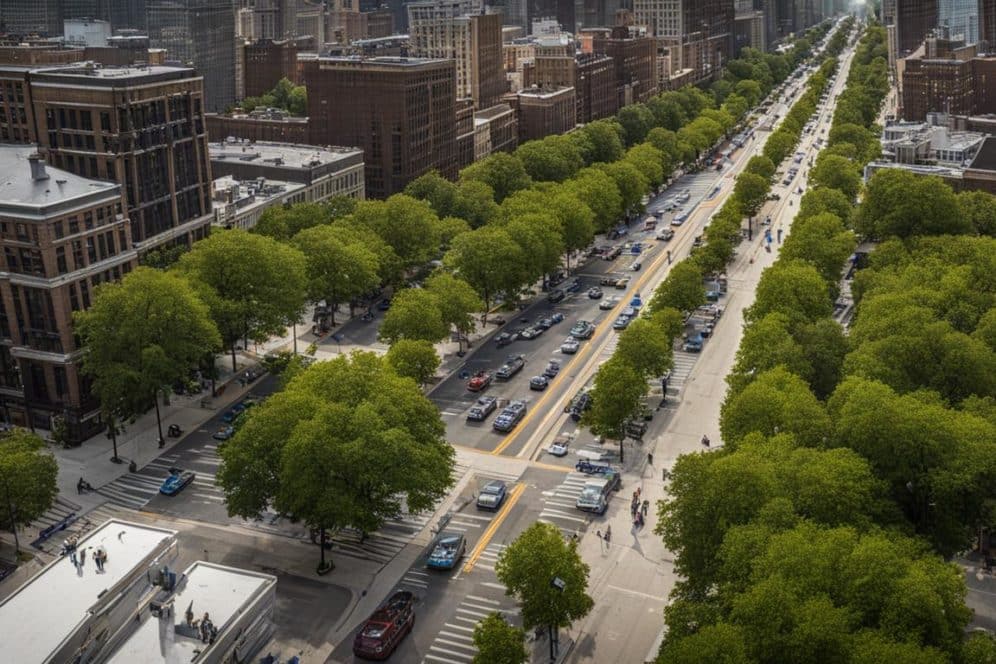Chicago is quickly becoming a haven for biking and walking enthusiasts, with its commitment to creating safe and enjoyable routes throughout the city. Whether you prefer biking or walking, you can rest assured knowing that Chicago offers a multitude of options that cater to your needs. From the expansive bike network to the carefully crafted pedestrian routes, Chicago has invested in ensuring the safety of its residents and visitors.
The city’s dedication to improving biking and walking infrastructure is evident in its comprehensive plan, the Chicago Cycling Strategy. This strategy outlines the city’s ambitious goal of expanding the bike network to over 500 miles of on-street bikeways and off-street trails. By focusing on neighborhoods that were previously underserved, the city aims to make biking and walking accessible to all Chicagoans.
With a growing emphasis on low-stress options for cycling, such as protected bike lanes, neighborhood greenways, and off-street trails, everyday biking has become safer and more convenient for everyone. Chicago’s commitment to safety extends beyond infrastructure as well, with a strong emphasis on proper bike fit and equipment to ensure rider safety.
Key Takeaways:
- Chicago has made significant investments in expanding and enhancing biking and walking infrastructure.
- The city’s bike network has grown to over 500 miles, with a focus on previously underserved neighborhoods.
- Low-stress options, such as protected bike lanes and off-street trails, make biking convenient for all Chicagoans.
- Proper bike fit and equipment are crucial for ensuring rider safety.
- The Lakefront Trail offers a scenic route for biking and walking along Chicago’s beautiful lakefront.
Importance of Proper Bike Fit and Equipment
When it comes to bike safety, proper bike fit and equipment play a critical role. Your bike should be the right size for your height, weight, and riding style. Selecting a bike frame size that suits your body proportions will ensure comfort and control while riding. Adjusting the seat height is also important to prevent strain on your knees and ensure optimal pedaling efficiency.
Another essential piece of equipment is a helmet. Wearing a helmet is crucial for protecting your head in case of accidents. Make sure your helmet fits properly and is securely fastened. Additionally, consider adding lights and reflectors to your bike to increase visibility, especially when riding in low-light conditions.
Regular maintenance and checks are vital to ensure your bike is in good working condition. Checking your tires, brakes, and gears regularly can help identify any repair problems and address them promptly. A properly maintained bike will not only enhance your safety but also contribute to a smooth and enjoyable riding experience.
Benefits of Proper Bike Fit and Equipment:
- Enhanced comfort and control while riding
- Reduced risk of strain and injuries
- Increased visibility and safety on the road
- Improved pedaling efficiency
- Longer lifespan and performance of your bike
Table: Essential Bike Equipment
| Equipment | Description |
|---|---|
| Helmet | A protective headgear that reduces the risk of head injuries. |
| Lights and Reflectors | Enhances visibility, especially during low-light conditions. |
| Flat Fixer | A tool or kit to repair a flat tire during emergencies. |
| Bike Lock | Secures your bike when parked to prevent theft. |
| Bell or Horn | Alerts pedestrians and other cyclists of your presence. |
Expanding and Enhancing Bike Infrastructure in Chicago
Chicago is committed to expanding and enhancing its bike infrastructure to create a more bike-friendly city. With the goal of making everyday cycling safe and convenient for all residents, the city has taken significant steps to grow its bike network and develop low-stress bikeways.
Chicago’s Bike Network Expansion
The bike network in Chicago has more than doubled since 2010, with a focus on creating connected routes that cater to cyclists of all abilities. The Chicago Cycling Strategy, introduced in Spring 2023, aims to design and implement 150 miles of new bikeways, upgrade existing ones, and fill network gaps. This expansion includes the addition of protected bike lanes, neighborhood greenways, and off-street trails.
The city’s bike network growth has prioritized previously underserved neighborhoods, with a focus on the south and west sides of Chicago. This community-driven approach aims to ensure that all residents have access to safe and convenient biking options. By expanding the bike network into more neighborhoods, Chicago is working towards creating a citywide network of continuous bikeways that connect all parts of the city.
Neighborhood Bike Networks and Low-Stress Bikeways
Chicago is also implementing a neighborhood-focused approach to bike infrastructure development. The city is rapidly expanding its Neighborhood Bike Networks, which are designed to connect communities and provide accessible and low-stress routes for cycling. By focusing on one neighborhood at a time, Chicago aims to create a network that prioritizes safety, ease of use, and connectivity.
| Benefit | Explanation |
|---|---|
| Improved Safety | The expansion of bike infrastructure in Chicago includes the creation of protected bike lanes, which separate cyclists from vehicle traffic, reducing the risk of accidents. |
| Increased Ridership | By providing safe and convenient biking options, Chicago aims to encourage more residents to choose cycling as a mode of transportation, promoting a healthier and more sustainable city. |
| Equitable Access | The focus on expanding the bike network in underserved neighborhoods ensures that all residents have equal access to safe and convenient biking options, promoting equity in transportation. |
With these ongoing efforts to expand and enhance bike infrastructure, Chicago is well on its way to becoming a more bike-friendly city, prioritizing the safety and convenience of cyclists. Whether you’re a resident or a visitor, exploring Chicago on two wheels is an enjoyable and sustainable way to experience the city’s vibrant neighborhoods, scenic views, and cultural attractions.
Chicago’s Scenic Lakefront Trail
The Lakefront Trail in Chicago is a must-visit for outdoor enthusiasts and nature lovers. This 18-mile paved path offers breathtaking views of Lake Michigan, making it the perfect setting for biking and walking. Whether you’re a resident or a visitor, you can explore the trail and immerse yourself in the beauty of Chicago’s lakefront.
The trail meanders through various lakefront neighborhoods, including Edgewater, Uptown, Lakeview, Lincoln Park, South Loop, Bronzeville, and Hyde Park. Along the way, you’ll discover a myriad of attractions, such as pristine beaches, cultural institutions, and waterfront dining options. It’s a fantastic opportunity to combine outdoor activities with scenic exploration, all while enjoying the refreshing lake breeze.
To ensure a pleasant experience, remember to follow safety guidelines when using the Lakefront Trail. Give pedestrians the right of way, wear appropriate protective gear, and always signal when passing others. By doing so, you can ensure the safety of everyone using the trail and contribute to a positive and enjoyable environment.
Whether you’re biking, walking, running, or rollerblading, the Chicago Lakefront Trail offers an incredible experience that will leave you captivated by the city’s natural beauty. Don’t miss out on this scenic gem that showcases the best of Chicago’s lakefront attractions.

